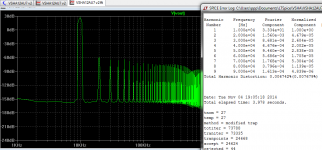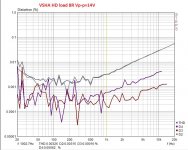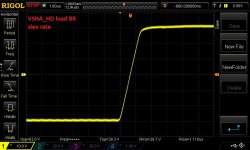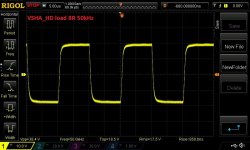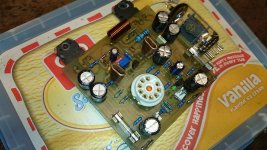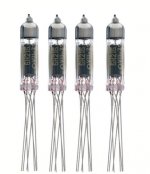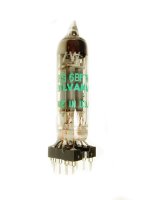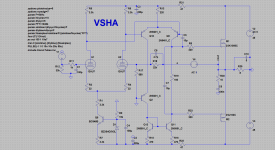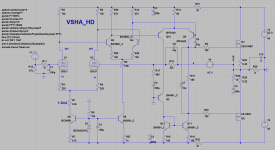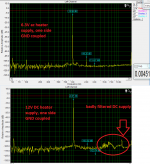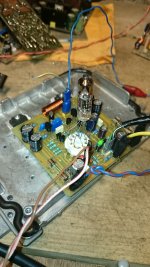Hello
Inspired by few recent projects I have decided to try a very simple/basic hybrid to stard with.
I like the Hitachi VAS sound so why not to stick a triode input in front of it ?
I have never worked on the vacuum tubes before so I would be very gratefull if someone can guide me to the right dirrection and give me some advice.
I have supplied the amp from 2x30Vac transformer PSU unit, the heater is supplied temporrary from the lab psu. The thd figures arent great but the amp sound suprisingly good, I was really blown away at the first time I hooked it up to the speakers (or maybe I was too excited).
I am going to build another version with another LTP stage, so I would be able to set the triode ''working point'' in more correct way.
The animal:
-input 12AU7 --> biased at 1.7mA total (two triodes), the cathodes are at +1,8V, the anode load resistors are only 3.3k (prapobly it is wrong but with the simple/education version it must be at that point)
-VAS --> Hitachi biased at 9-10mA total, looks that 5mA is enough to drive correctly the pair of renesas mosfets.
-output --> lateral mosfets from Renesas
Special thanks for OS and Valery for helping me!!
Inspired by few recent projects I have decided to try a very simple/basic hybrid to stard with.
I like the Hitachi VAS sound so why not to stick a triode input in front of it ?
I have never worked on the vacuum tubes before so I would be very gratefull if someone can guide me to the right dirrection and give me some advice.
I have supplied the amp from 2x30Vac transformer PSU unit, the heater is supplied temporrary from the lab psu. The thd figures arent great but the amp sound suprisingly good, I was really blown away at the first time I hooked it up to the speakers (or maybe I was too excited).
I am going to build another version with another LTP stage, so I would be able to set the triode ''working point'' in more correct way.
The animal:
-input 12AU7 --> biased at 1.7mA total (two triodes), the cathodes are at +1,8V, the anode load resistors are only 3.3k (prapobly it is wrong but with the simple/education version it must be at that point)
-VAS --> Hitachi biased at 9-10mA total, looks that 5mA is enough to drive correctly the pair of renesas mosfets.
-output --> lateral mosfets from Renesas
Special thanks for OS and Valery for helping me!!
Attachments
-
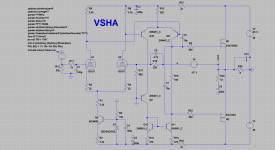 VSHA simple.png64.1 KB · Views: 6,407
VSHA simple.png64.1 KB · Views: 6,407 -
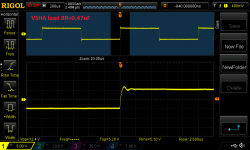 1k cap load.png32.9 KB · Views: 629
1k cap load.png32.9 KB · Views: 629 -
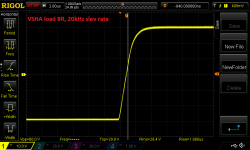 SR.png32.1 KB · Views: 615
SR.png32.1 KB · Views: 615 -
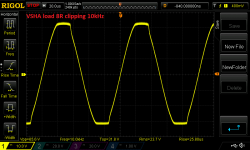 clipping 10k.png37.8 KB · Views: 662
clipping 10k.png37.8 KB · Views: 662 -
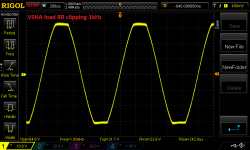 clipping 1k.png37.4 KB · Views: 4,264
clipping 1k.png37.4 KB · Views: 4,264 -
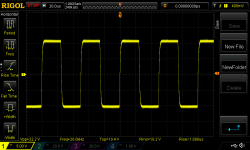 20kHz.png41.7 KB · Views: 4,543
20kHz.png41.7 KB · Views: 4,543 -
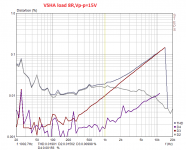 thd15v.png22.8 KB · Views: 4,884
thd15v.png22.8 KB · Views: 4,884 -
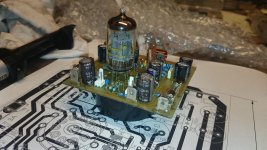 DSC_3133.jpg846.6 KB · Views: 6,166
DSC_3133.jpg846.6 KB · Views: 6,166 -
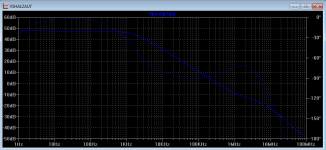 bode simple.png31.4 KB · Views: 505
bode simple.png31.4 KB · Views: 505 -
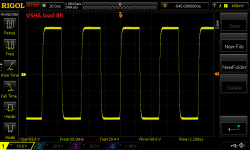 20kHz 60V.png35.5 KB · Views: 658
20kHz 60V.png35.5 KB · Views: 658
Last edited:
It sound very well in the whole top octave. It is maybe a bit to bright/sharp (seas 22taf/g with aluminium dome) but this can be tweaked at further development. The amp has its signature, lot of air and plenty background details, mids and vocals are very plesent to listen. Overal I am very happy from the amp as it was only an educational experiment. The HD version will be ready next weak.
thx
thx
If your "HD" version is ready, will you share your PCB design with us? This is an area (tube-FET direct coupled hybrid amps) where I experimented a bit, with very good results, so I am excited to try your version....
How do you plan to solve the startup issue? I guess heater supply first, then delayed supply rails + muting for the output?
How do you plan to solve the startup issue? I guess heater supply first, then delayed supply rails + muting for the output?
You may find better results referencing the heater to the positive rail. Also since the VAS is balanced you may be able to side step start delays etc. by simply placing a large value resistor from plate to cathode of each tube.
jerluwoo
Thanks for advice !!
After I have referenced the DC12.6v heater to ground, the amp is dead quied with no signal. Tell me please around 220k around cathode and plate would be ok ?
Automatic amplifier turn on --> I was going to use triode ccs resistor 3.3k, when vacuum tubes start to consume the bias current the voltage drop across it will reach approx 5.5V and then the speaker relay will turn on, but first I must finish the amp.
The HD version is showing much lower distortion in Spice, wondering how it will look like in real life.
Bellow eagle files of simple version if some one would like to play with it.
dragonweed
I will share the all documentation after I will test and listen to it.
The simple version is singing very nice, I am wondering how about HD version too.
Regards
Peter
edit:
I have forgotten to mention, the eagle board is kind of universal, the amp can be AC or DC coupled, I have used AC coupled version.
Thanks for advice !!
After I have referenced the DC12.6v heater to ground, the amp is dead quied with no signal. Tell me please around 220k around cathode and plate would be ok ?
Automatic amplifier turn on --> I was going to use triode ccs resistor 3.3k, when vacuum tubes start to consume the bias current the voltage drop across it will reach approx 5.5V and then the speaker relay will turn on, but first I must finish the amp.
The HD version is showing much lower distortion in Spice, wondering how it will look like in real life.
Bellow eagle files of simple version if some one would like to play with it.
dragonweed
I will share the all documentation after I will test and listen to it.
The simple version is singing very nice, I am wondering how about HD version too.
Regards
Peter
edit:
I have forgotten to mention, the eagle board is kind of universal, the amp can be AC or DC coupled, I have used AC coupled version.
Attachments
Last edited:
The HD version is working now. There is hidden diode in the tube socket to make them look nicer 😛
The quick home made measurements bellow, the amp is stable, there is no oscillations present when the tube heater and main psu are powered at the same time, only DC is going bit up/down until the NFB is starting to work (heater takes around 5-8s to heat up the tube).
Unfortunatly I have pulse regulated psu for the heater so there are small artefacts present at the output (with good filtered supply all is OK).
Now there is some time for the listening tests of both versions.
Suprisingly the different tube gives a bit different sound signature.
The quick home made measurements bellow, the amp is stable, there is no oscillations present when the tube heater and main psu are powered at the same time, only DC is going bit up/down until the NFB is starting to work (heater takes around 5-8s to heat up the tube).
Unfortunatly I have pulse regulated psu for the heater so there are small artefacts present at the output (with good filtered supply all is OK).
Now there is some time for the listening tests of both versions.
Suprisingly the different tube gives a bit different sound signature.
Attachments
Yes, it's written on ice cream box: Happy message in every tube.🙂Suprisingly the different tube gives a bit different sound signature.
Hi Peter!
Wow 🙂 Just noticed your thread 🙄
Congratulations, a very cool project!
I'm curious, what is the difference between the HD version and initial one on terms of schematic?
BTW, in my hybrids I have supply for the heaters - 6.3V AC from a small separate transformer (heaters are paralleled) just "floating" - no problem.
Cheers,
Valery
Wow 🙂 Just noticed your thread 🙄
Congratulations, a very cool project!
I'm curious, what is the difference between the HD version and initial one on terms of schematic?
BTW, in my hybrids I have supply for the heaters - 6.3V AC from a small separate transformer (heaters are paralleled) just "floating" - no problem.
Cheers,
Valery
Valery
Bellow both schematics. On the HD version I have added another LTP so I can set the tube working point in any way I need, there is quite a lot of gaian availible.
I just have noticed that there are some nice sub miniature tubes availible, and some of them are low voltage audio ones so I will maybe try them on. Please take a look if you can at 6N16B, 6N21B or 6BF7W ant tell me what you think.
The first educational version sound really good, smooth nice sound. The HD I will have to listen to it more to compare them. Most important is fun and satysfaction. Project is very simple.
Some of the people recommend to ''atatch'' the heater reference at the positive rail voltage, in my case +45V. I do not really know what is the diffrence. There is still lot of things to learn.
Both amps are AC coupled but I have putted a trim pot at the triode just in case I will use DC coupled version. Can You tell me what are the advantages of DC coupled amp please ? THX
Regards Peter
Bellow both schematics. On the HD version I have added another LTP so I can set the tube working point in any way I need, there is quite a lot of gaian availible.
I just have noticed that there are some nice sub miniature tubes availible, and some of them are low voltage audio ones so I will maybe try them on. Please take a look if you can at 6N16B, 6N21B or 6BF7W ant tell me what you think.
The first educational version sound really good, smooth nice sound. The HD I will have to listen to it more to compare them. Most important is fun and satysfaction. Project is very simple.
Some of the people recommend to ''atatch'' the heater reference at the positive rail voltage, in my case +45V. I do not really know what is the diffrence. There is still lot of things to learn.
Both amps are AC coupled but I have putted a trim pot at the triode just in case I will use DC coupled version. Can You tell me what are the advantages of DC coupled amp please ? THX
Regards Peter
Attachments
"Some of the people recommend to ''atatch'' the heater reference at the positive rail voltage, in my case +45V"
Cathode and heater are in close contact.If the votage difference between them is big there is the risk of a spark.
In your case (+45v) there isn't any reason to worry about this.
Cathode and heater are in close contact.If the votage difference between them is big there is the risk of a spark.
In your case (+45v) there isn't any reason to worry about this.
Last edited:
thimios
Thanks for info!!
I am just wondering what profit I will have from referencing the heater voltage at my rail voltage.
Regards Peter
Thanks for info!!
I am just wondering what profit I will have from referencing the heater voltage at my rail voltage.
Regards Peter
I have decided to use 6.3V ac heater instead DC. There is absolutley no hum at the output. With poor DC filtered heater supply (in my case pulse regulated) I had some visible artefacts at FFT. Sound is really nice.
I am going to test few more improvements.
I am surprised that 12ua7a tube is doing so good job at so low anode voltage, it will be hard to beat it by other tubes.
Now I am testing 6N16B at the input but prapobly I will have to prepare a new pcb for it because putting the tiny wires into the 9pin socket drive me crazy....
Bellow VSHA_HD full documentation if someone will need it.
I am going to test few more improvements.
I am surprised that 12ua7a tube is doing so good job at so low anode voltage, it will be hard to beat it by other tubes.
Now I am testing 6N16B at the input but prapobly I will have to prepare a new pcb for it because putting the tiny wires into the 9pin socket drive me crazy....
Bellow VSHA_HD full documentation if someone will need it.
Attachments
Member
Joined 2009
Paid Member
12AU7 is known to be good at low voltages with regards minimal grid current - an issue that plagues other tubes from this family at low voltages.
I have decided to use 6.3V ac heater instead DC. There is absolutley no hum at the output. With poor DC filtered heater supply (in my case pulse regulated) I had some visible artefacts at FFT. Sound is really nice.
I am going to test few more improvements.
I am surprised that 12ua7a tube is doing so good job at so low anode voltage, it will be hard to beat it by other tubes.
Now I am testing 6N16B at the input but prapobly I will have to prepare a new pcb for it because putting the tiny wires into the 9pin socket drive me crazy....
Bellow VSHA_HD full documentation if someone will need it.
Great job Peter!
I also use 6.3V AC for the heater - no problem at all.
Never tried those "small" tubes - very interesting to see your results 😎
Keep it up! 😉
12AU7 is known to be good at low voltages with regards minimal grid current - an issue that plagues other tubes from this family at low voltages.
Yes!

Valery
Have you ever tryed to use ''symetrised'' heater supply, I mean to connect two additional 100R resistors to the 6.3V ac winding and reference centre point to the GND ?
-------------6.3V------------(trafo winding)
-------(100R)---(100R)-------(two resistors)
-PIN4,5------GNDref-----PIN9-(triode)
I found connection like this and I am wondering if it will bring any improvement.
Bigun
I am trying to find some small tube now so I can put it in DIP8 socket but it will be hard to beat 12au7 anyway.
thx
Peter
Have you ever tryed to use ''symetrised'' heater supply, I mean to connect two additional 100R resistors to the 6.3V ac winding and reference centre point to the GND ?
-------------6.3V------------(trafo winding)
-------(100R)---(100R)-------(two resistors)
-PIN4,5------GNDref-----PIN9-(triode)
I found connection like this and I am wondering if it will bring any improvement.
Bigun
I am trying to find some small tube now so I can put it in DIP8 socket but it will be hard to beat 12au7 anyway.
thx
Peter
thimios
I have 12ax7 (jj ecc83-s) i am going to try it, but I do not know if it will work with as small anode voltage, thanks for info !
I have 12ax7 (jj ecc83-s) i am going to try it, but I do not know if it will work with as small anode voltage, thanks for info !
- Home
- Amplifiers
- Solid State
- Very Simple Hybrid Ampifier

